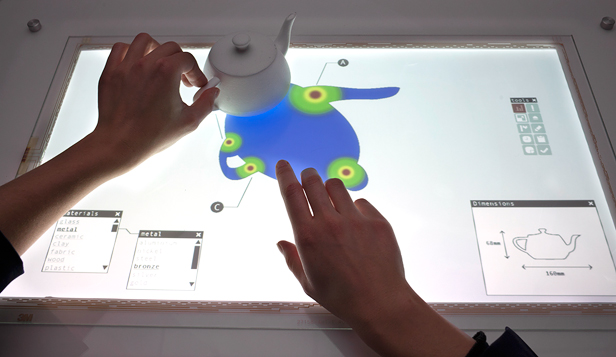Disney Researchers Add Virtual Touch to the Real World
A new computer interface can modify the feel of almost any surface—potentially adding a new dimension to games and augmented reality apps.
Researchers at Disney have demonstrated a computer interface that changes the way ordinary, everyday objects feel using a weak electric signal fed through a user’s entire body.
Revealed at the Siggraph 2012 conference in Los Angeles this weekend, wearable technology modifies a user’s tactile perception of the physical world without requiring him to wear special gloves or use a force-feedback device. Sensations can be induced when the wearer touches a computer screen, walls, furniture, plastic or wooden objects, even other people.
Computer interface research has accelerated in recent years as hardware has become cheaper and software more sophisticated. This research has led to new products, including multitouch screens (see “iPhone-Style Touch on a Giant Screen”), motion-sensing devices (see “Microsoft Kinect” and “Gestural Interfaces”), and glasses-free 3-D displays (see “A Glimpse of Glasses-Free 3-D”). One area of growing interest is touch, or haptics, although this normally involves having users interact with a specialized device, and it has so far seen limited commercial application (see “The Slow Rise of the Robot Surgeon”).
This story is only available to subscribers.
Don’t settle for half the story.
Get paywall-free access to technology news for the here and now.
Subscribe now
Already a subscriber?
Sign in
The Disney interface exploits a tactile effect known as “reverse electrovibration,” and has been dubbed REVEL. An imperceptible electrical signal is introduced across the user’s whole body to create an oscillating electrostatic field around the skin. When touching a physical object, such as a tablet screen, that shares a common electrical ground with the REVEL signal generator, an electrostatic force modulates the friction between the sliding finger and the object to create the sensation of a texture.
“Sight and sound are important, but we believe the addition of touch can create a really unique and magical experience,” says Olivier Bau, lead researcher on the REVEL project. “Instead of making objects and devices simulate tactile effect, we are changing your feeling of the real world. We are altering human perception. The rest of the world remains passive.”
By tracking the objects that a person is touching, an interface could combine augmented reality imagery, on a smartphone or tablet screen, with virtual tactile sensations provided by the REVEL device.
Varying the properties of the signal, such as the shape, amplitude, and frequency, can provide a wide range of tactile sensations, according to Ivan Poupyrev, another Disney research scientist working on the project.
“The sensations at this point are carefully designed and range from feeling virtual pebbles, to fine textures, such as sand, to glassy or rubbery materials, to larger spatial geometrical patterns such as grooves, bumps,” he says. “A lot more work needs to be done to design and investigate really rich tactile sensations with this technology.”
The REVEL device can coordinate tactile sensations with images on almost any surface, including walls and tables, providing they have a conductive element. Paint on a wall, for example, could include copper emulsion to make it conductive, according to the Disney lab.
Users do not have to be directly connected to the REVEL input via electrodes, because the weak signals sent from the REVEL device, which could be embedded in a chair, a shoe, or the casing of a touch screen, can still pass safely into the user’s body.
Possible applications include guides and augmentation for the blind and, perhaps further in the future, augmented images and films from the entertainment industry—like the “Feelies” Aldous Huxley predicted in his 1932 futurist novel Brave New World.
“REVEL could change the feel of objects in a bespoke environment, according to what ‘story’ you are in. It could augment reality with new textures,” says Carl Telford, an analyst at U.K.-based electronics business consultants Strategic Business Insights.
“What is really interesting is that it doesn’t require the surface of the object being touched to change, so it could prove flexible and perhaps cheap to implement, although I think it’s likely at least a decade away from commercialization.”
